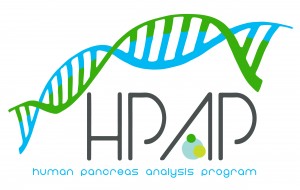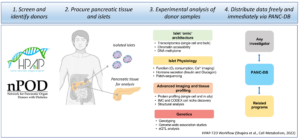HPAP T2D: Human Pancreas Analysis Program (Univ. Pennsylvania)
Contact PI: Klaus Kaestner, PhD, University of Pennsylvania (U01DK123594)
Ali Naji, MD, PhD, Investigator, University of Pennsylvania
Ben Voight, PhD, Investigator, University of Pennsylvania
Doris Stoffers, MD, PhD, co-Investigator, University of Pennsylvania
Jason Moore, PhD, co-Investigator, University of Pennsylvania (09/2019-11/2021)
Michael Feldman, MD, PhD, co-Investigator, University of Pennsylvania (09/2019 – 03/2023)
Babak Faryabi, PhD, co-Investigator, University of Pennsylvania (11/2021-present)
Start Date: September 30, 2019
Abstract
The past decades have seen a dramatic improvement in our ability to phenotype and molecularly profile human tissues relevant to the etiology of type 2 diabetes with unprecedented resolution, at the genomic, epigenomic, protein, and functional levels. Here we will employ state-of-the-art technologies to determine all aspects of pancreas biology as it pertains to type 2 diabetes, profile human pancreatic islets with multiple assay modalities, and make the vast data accumulated available through the highly accessible PANC-DB. This comprehensive profiling of the natural history of Type 2 diabetes will pave the way for future discoveries of new treatment modalities for diabetes.
 |
 |
Meet the Grant Team
Investigators |
|
Klaus Kaestner, PhDUniversity of Pennsylvania |
Ali Naji, MD, PhDUniversity of Pennsylvania |
Ben Voight, PhDUniversity of Pennsylvania |
|
Doris Stoffers, MD, PhDUniversity of Pennsylvania |
Jason Moore, PhDUniversity of Pennsylvania
|
Michael Feldman, MD, PhDUniversity of Pennsylvania
|
Publications
- Supervised machine learning identifies impaired mitochondrial quality control in β cells with development of type 2 diabetes
- Altered immune and metabolic molecular pathways drive islet cell dysfunction in human type 1 diabetes
- Single-cell multiome and spatial profiling reveals pancreas cell type-specific gene regulatory programs of type 1 diabetes progression
- Integrative single-cell multi-omics profiling of human pancreatic islets identifies T1D-associated genes and regulatory signals
- The antigen presentation landscape of cytokine-stressed human pancreatic islets
- Epigenetic adaptation of beta cells across lifespan and disease: age-related demethylation is advanced in type 2 diabetes
- Spatial transcriptomics from pancreas and local draining lymph node tissue reveals a lymphotoxin-β signature in human type 1 diabetes
- Immune perturbations in human pancreas lymphatic tissues prior to and after type 1 diabetes onset
- Functional and Mechanistic Explanation for the Unique Clinical Success of the Glucokinase Activator Dorzagliatin in the Treatment of Type 2 Diabetes
- Closing the Gap Between Vision and Victory in Type 1 Diabetes: The NIDDK Human Islet Research Network (HIRN) Initiative
- Single-cell multiome and spatial profiling reveals pancreas cell type-specific gene regulatory programs driving type 1 diabetes progression
- IFN-α Induces Heterogenous ROS Production in Human β-Cells
- The XCL1/XCR1 axis is upregulated in type 1 diabetes and aggravates its pathogenesis
- TMEM55A-mediated PI5P signaling regulates α-cell actin depolymerization and glucagon secretion
- G6PC2 controls glucagon secretion by defining the set point for glucose in pancreatic α cells
- Heterogeneous endocrine cell composition defines human islet functional phenotypes
- The IsletTester mouse: an immunodeficient model with stable hyperglycemia for the study of human islets
- Sex-specific regulatory architecture of pancreatic islets from subjects with and without type 2 diabetes
- Human peripancreatic adipose tissue paracrine signaling impacts insulin secretion, blood flow, and gene transcription
- HumanIslets.com: Improving accessibility, integration, and usability of human research islet data
- Immune perturbations in human pancreas lymphatic tissues prior to and after type 1 diabetes onset
- Single cell multiome profiling of pancreatic islets reveals physiological changes in cell type-specific regulation associated with diabetes risk
- Single-cell multi-omic and spatial profiling of human kidneys implicates the fibrotic microenvironment in kidney disease progression
- No evidence for persistent enteroviral B infection of pancreatic islets in type 1 diabetic and pre-diabetic patients from RNA-Seq data
- Identification of unique cell type responses in pancreatic islets to stress
- HumanIslets: An integrated platform for human islet data access and analysis
- AnnoSpat annotates cell types and quantifies cellular arrangements from spatial proteomics
- NKX2-2 based nuclei sorting on frozen human archival pancreas enables the enrichment of islet endocrine populations for single-nucleus RNA sequencing
- DNA methylation-based assessment of cell composition in human pancreas and islets
- RFX6 maintains gene expression and function of adult human islet α cells
- Exocrine pancreas in type 1 and type 2 diabetes: different patterns of fibrosis, metaplasia, angiopathy, and adiposity
- Benchmarking algorithms for joint integration of unpaired and paired single-cell RNA-seq and ATAC-seq data
- The leptin receptor has no role in delta-cell control of beta-cell function in the mouse
- An Integrated Map of Cell Type-Specific Gene Expression in Pancreatic Islets
- Pericyte dysfunction and impaired vasomotion are hallmarks of islets during the pathogenesis of type 1 diabetes
- Inferring regulators of cell identity in the human adult pancreas
- An integrated map of cell type-specific gene expression in pancreatic islets
- Understanding islet dysfunction in type 2 diabetes through multidimensional pancreatic phenotyping: The Human Pancreas Analysis Program
- Aging compromises human islet beta cell function and identity by decreasing transcription factor activity and inducing ER stress
- 3D chromatin maps of the human pancreas reveal lineage-specific regulatory architecture of T2D risk
- Adaptation to chronic ER stress enforces pancreatic β-cell plasticity
- α Cell dysfunction in islets from nondiabetic, glutamic acid decarboxylase autoantibody-positive individuals
- Variant-to-gene-mapping analyses reveal a role for pancreatic islet cells in conferring genetic susceptibility to sleep-related traits
- Limited extent and consequences of pancreatic SARS-CoV-2 infection
- Islet Lymphocytes Maintain a Stable Regulatory Phenotype Under Homeostatic Conditions and Metabolic Stress
- Single-cell analysis of the human pancreas in type 2 diabetes using multi-spectral imaging mass cytometry
- What is a β cell? – Chapter I in the Human Islet Research Network (HIRN) Review Series
- Pancreatic islet reserve in type 1 diabetes
- SARS-CoV-2 Cell Entry Factors ACE2 and TMPRSS2 Are Expressed in the Microvasculature and Ducts of Human Pancreas but Are Not Enriched in β Cells







